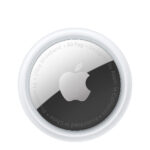Finding the ideal bicycle lock can feel overwhelming. The market is saturated with options, and making the wrong choice can lead to devastating consequences – bike theft. The key is to select a lock that offers robust security and is convenient for your daily use.
This crucial balance between strength and practicality is my priority when evaluating bike locks. Since 2015, I’ve dedicated myself to rigorously testing and writing about bicycle security, giving me the experience to guide you effectively.
Below, I recommend 6 of the best bike locks, carefully selected based on their security ratings and real-world performance in my user tests.
If none of these perfectly match your needs, don’t worry. Following these reviews, I’ll present three straightforward steps, including a quick risk assessment quiz, to ensure you find the recommended bike lock that’s perfect for you.
1. Litelok X1
The Litelok X1 stands out as the best all-around bike lock in 2024. Its exceptional feature is providing genuine protection against cordless angle grinders, a tool increasingly favored by bike thieves.
In today’s landscape, the Litelok X1 remains unique, offering angle grinder resistance while maintaining an optimal balance of high security, everyday usability, and reasonable pricing for cyclists needing enhanced protection.
Angle grinder attacks are alarmingly prevalent, becoming a primary method of bike theft in many areas, especially when bikes are secured with less substantial cable locks. Until recently, no lock could withstand an angle grinder for more than a minute. The arrival of locks like the Litelok X1 and Hiplok D1000, capable of resisting these attacks, is therefore a significant advancement.
 Litelok X1 securing a bicycle front wheel
Litelok X1 securing a bicycle front wheel
Image: Litelok X1 bike lock securing the front wheel of a bicycle, demonstrating its practical application and robust design.
What distinguishes the Litelok X1?
Functionally and visually, the Litelok X1 resembles a traditional u-lock. It’s slightly shorter than standard u-locks, but the difference is negligible, less than 2 cm, ensuring no practical inconvenience during use.
The critical innovation lies within its construction: a ceramic composite material is fused to its 16 mm shackle. This specialized material effectively degrades angle grinder discs as they attempt to cut through the lock, significantly increasing resistance time.
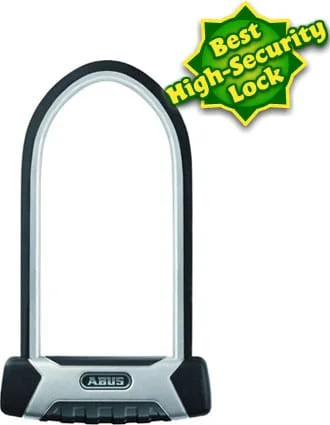 Close-up of Litelok X1 showcasing its robust construction as a recommended bike lock
Close-up of Litelok X1 showcasing its robust construction as a recommended bike lock
Image: Detailed view of the Litelok X1 bike lock, highlighting its material composition and robust shackle design as a highly recommended security solution.
| Litelok X1 |
|—|—|
| My score: | |
| Check price: | > Check Litelok X1 Price |
| Shackle thickness: | 16 mm |
| Weight: | 3.7 lb (1.7 kg) |
| Size (internal): | 3.97 x 7.7″ (10.1 x 19.6 cm) |
| Security Ratings: | |
In my rigorous testing, cutting through just one side of the Litelok X1 took over four times longer compared to the Kryptonite New York Fahgettaboudit, previously considered the most secure bike lock before the X1 and D1000 emerged. In fact, during my initial test, I exhausted all my cutting discs before breaching even one side of the Litelok X1, failing to compromise it entirely.
The Litelok X1’s impressive performance is widely recognized. It’s among the select few bike locks, alongside other angle grinder resistant models, to achieve a Sold Secure Powered Cycle Diamond rating, affirming its superior security level.
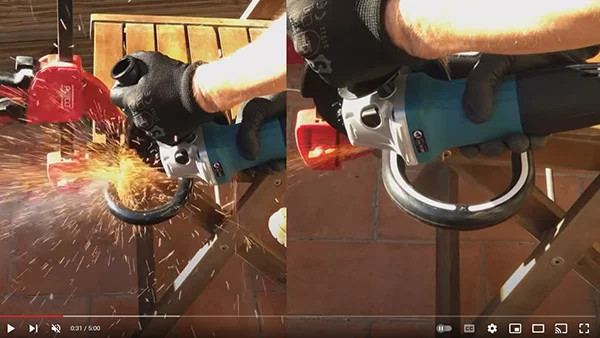 Still image from angle grinder test video of Litelok X1 recommended bike lock
Still image from angle grinder test video of Litelok X1 recommended bike lock
Image: A frame from a video showcasing the angle grinder resistance test of the Litelok X1, a top recommended bike lock for high-security needs.
Is it flawless? Not quite.
Initially, my Litelok X1 was a bit stiff to lock, although a simple DIY adjustment quickly resolved this, and I’ve been informed that the manufacturer has since corrected this issue.
More importantly, while highly secure, it’s not as formidable as the Hiplok D1000 (and DX1000), or the Litelok X3. These models resisted cutting for 2.5 and 3 times longer per side, respectively, in my tests.
So, why isn’t the Hiplok D1000 or Litelok X3 my top recommendation for 2024? Both are exceptional locks, undeniably the strongest bicycle locks currently available.
 Comparison image of Litelok X1, Litelok X3, and Hiplok D1000, highlighting top recommended bike locks
Comparison image of Litelok X1, Litelok X3, and Hiplok D1000, highlighting top recommended bike locks
However, their price points are considerably higher. They are also significantly heavier and less portable than the Litelok X1. The Hiplok D1000, in particular, is also smaller than the Litelok X1, which might limit its practicality for some cyclists. (Note: the Hiplok DX1000 addresses the size issue).
The Litelok X1 strikes an excellent balance of security, usability, and cost. Its practical size, convenient frame mount, and competitive price (only slightly more expensive than the Abus Granit X Plus 540 and nearly half the price of the Hiplok D1000!) make it the sensible choice for most cyclists seeking an angle grinder resistant recommended bike lock.
For a deeper dive, read my comprehensive Litelok X1 review, which includes a video comparing its angle grinder resistance to the Fahgettaboudit, or my comparison of the Litelok X1 vs Hiplok D1000. Also, check my page dedicated to angle grinder resistant bike locks for the latest models as new ones are constantly being developed.
2. Kryptonite Kryptolok New-U
Not everyone requires angle grinder level protection. I strongly recommend taking my brief 3-question quiz to assess your risk level and determine if an angle grinder resistant lock is truly necessary for you.
For those in lower-risk environments, the Kryptonite Kryptolok New-U, an enhanced version of the popular Kryptolok Series 2, offers a fantastic, budget-friendly alternative and a highly recommended bike lock.
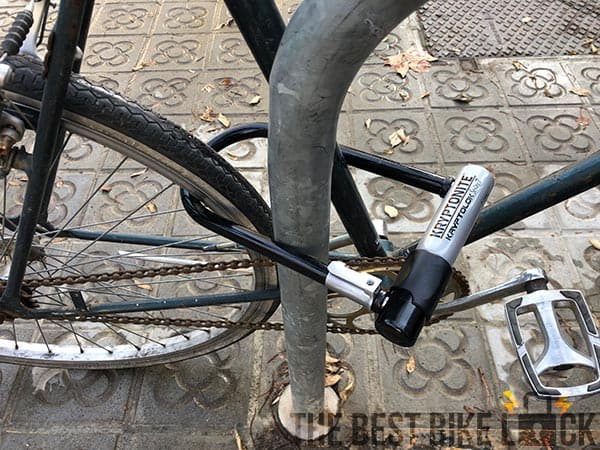 Kryptonite Kryptolok Standard securing a bicycle wheel, highlighting its recommendation as a medium security lock
Kryptonite Kryptolok Standard securing a bicycle wheel, highlighting its recommendation as a medium security lock
Image: The Kryptonite Kryptolok Standard bike lock effectively securing the back wheel of a bicycle, illustrating its role as a recommended medium-security solution.
By upgrading the shackle to lock on both sides, instead of just one, the Kryptolok has achieved a Sold Secure Gold rating, up from Silver. However, its 2/5 star rating from ART indicates it remains a medium-security lock, perfectly suited for many everyday situations.
The standout feature of the Kryptolok is its user-friendliness. It’s relatively lightweight, comparable to 3.5 cans of soda, and with proper frame mount attachment, it’s easily portable while cycling. Additionally, its generous size provides ample space for securing your bike in various locations and scenarios.
 Kryptonite Kryptolok New-U, a best mid-security recommended bike lock, product shot
Kryptonite Kryptolok New-U, a best mid-security recommended bike lock, product shot
Image: A product shot of the Kryptonite Kryptolok New-U bike lock, emphasizing its design and features as a top recommended mid-security option.
| Kryptonite Kryptolok New U |
|—|—|
| My score: | |
| Check price: | > Check Amazon Price |
| Shackle thickness: | 12.7 mm |
| Weight: | 2.9 lb (1.32 kg) |
| Size (internal): | 4 x 9″ (10.2 x 22.9 cm) |
| Kryptonite rating: | 6/10 |
| Security Ratings: | |
While I personally prefer the keyhole covers found on OnGuard locks for their effectiveness in preventing disc misalignment, this is a minor critique. Kryptonite’s customer service is arguably the best in the bike lock industry, offering significant benefits like free key replacements and reduced-price (or even free) lock replacements under certain conditions.
For those seeking a more secure Kryptonite lock, the Evolution range is worth considering. However, these options are typically heavier or smaller and still don’t offer angle grinder resistance.
However, if your risk profile is lower, the Kryptonite Kryptolok provides an easy-to-use and adequately protective recommended bike lock at a very reasonable price. Read my full, hands-on review of the Kryptolok for a deeper analysis and alternative suggestions if it’s not the perfect fit for you.
3. Foldylock Compact
Folding locks are gaining popularity as a versatile alternative to traditional bike locks. They are generally more portable and offer greater flexibility in locking scenarios. However, the selection of truly secure folding locks is limited.
Fortunately, some folding locks are definitely worth considering. The Foldylock Compact is the lightest folding lock that still provides a solid level of protection, earning a Sold Secure Silver rating, making it a recommended bike lock in its category. It’s also the most user-friendly folding lock I’ve tested.
 Foldylock Compact, lightest recommended folding bike lock securing a wheel
Foldylock Compact, lightest recommended folding bike lock securing a wheel
Image: Foldylock Compact securing the front wheel of a bicycle, showcasing its lightweight and compact design as a recommended folding bike lock.
The Foldylock Compact offers a 33″ (85 cm) length, providing similar internal locking space to a standard u-lock. Its flexible nature significantly expands your locking options compared to rigid u-locks. Weighing just 2.2 lb (1 kg), comparable to 2.5 cans of soda, it’s remarkably light. For even greater portability, a slightly shorter (75 cm) version is available, which also comes with a belt clip, eliminating the need for a frame mount.
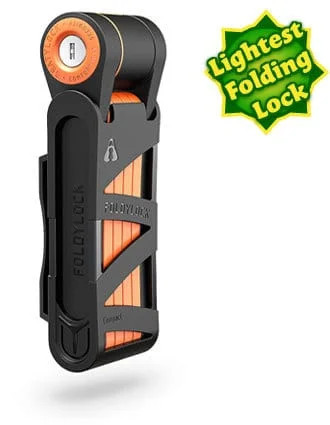 Foldylock Compact product shot showcasing its compact form, a recommended bike lock for portability
Foldylock Compact product shot showcasing its compact form, a recommended bike lock for portability
Image: Product view of the Foldylock Compact, highlighting its folded compactness and included mount, emphasizing its portability as a recommended bike lock.
| Foldylock Compact |
|—|—|
| My score: | |
| Check price: | > Check Amazon Price |
| Plate thickness: | 5 mm |
| Weight: | 2.2 lb (1 kg) |
| Length: | 33″ (85 cm) |
| Foldylock rating: | 14/18 |
| Security Ratings: | |
Compared to its closest competitor, the Abus Bordo 6000 (until the Abus lost its Sold Secure Silver rating), the Foldylock Compact is lighter and more user-friendly. It’s easier to unlock, unfold, maneuver around your bike, and includes a superior frame mount. Typically, it’s also more affordable. Check the Amazon price for current details.
If you operate in a lower-risk environment and seek a compact, flexible, and lightweight alternative to a u-lock, this is an excellent choice and a highly recommended bike lock. Read my hands-on review of the Foldylock Compact for more insights and alternative suggestions if it’s not the right fit. Or explore more of the best lightweight bike locks.
4. Foldylock Forever
Foldylock also offers a high-security folding lock, the Foldylock Forever. This is essentially a reinforced, heavy-duty version of their standard folding lock range (Classic, Compact, Mini, etc.). It’s built for enhanced security and is a top recommended bike lock for high-risk areas.
 Foldylock Forever securing a bicycle to a traffic light, showcasing its extended reach
Foldylock Forever securing a bicycle to a traffic light, showcasing its extended reach
Image: The Foldylock Forever bike lock easily securing a bicycle to a traffic light pole, demonstrating its extended length and versatility, making it a highly recommended option for flexible locking scenarios.
Measuring 35.4″ (90 cm), slightly longer than the Foldylock Compact, it offers even greater locking versatility. As illustrated, it effortlessly secures a bike to a traffic light, a feat impossible for most u-locks. More importantly, the arms are 6.5 mm thick, compared to 5 mm on their standard folding locks. This added 1.5 mm thickness is crucial for its Sold Secure Gold rating, a step up from the Silver rating of other Foldylocks.
The Foldylock Forever’s arms are also 1 mm thicker than other Sold Secure Gold rated folding locks, including the Abus Bordo 6500, Trelock FS 500 Toro, and Kryptonite Evolution 790. This extra thickness is complemented by a patented rivet protection system, designed to deter nut splitter attacks. While such attacks are rare on the street, they represent a known vulnerability in locks like the Abus Bordo 6500.
These enhanced security features make the Foldylock Forever the most secure folding lock currently available and the only one secure enough for mopeds and scooters as well as bicycles, making it a truly recommended bike lock for comprehensive security.
 Foldylock Forever, a high-security recommended bike lock, product view
Foldylock Forever, a high-security recommended bike lock, product view
Image: Product shot of the Foldylock Forever bike lock, emphasizing its robust construction and high-security features, solidifying its recommendation for superior bike protection.
| Foldylock Forever |
|—|—|
| My score: | |
| Check price: | > Check Amazon Price |
| Plate thickness: | 6.5 mm |
| Weight: | 3.88 lb (1.76 kg) |
| Length: | 35.4″ (90 cm) |
| Foldylock rating: | 18/18 |
| Security Ratings: | |
The high security level does come with increased weight. At 3.88 lb (1.76 kg), it’s a heavier lock, weighing slightly more than 4.5 cans of soda. However, like all Foldylocks, it excels in usability. It’s easy to unlock, smooth to unfold and refold, and provides more internal locking space than a standard u-lock, offering numerous locking possibilities.
While some reviews suggest the lock can fit too tightly or loosely in its mount, I experienced neither issue. Like the Classic model, the Forever slides smoothly in and out of its plastic mount, sitting snugly and securely without rattling during rides.
Moreover, despite its high security, the Foldylock Forever is competitively priced. Check prices on Amazon; it’s often more affordable than the Abus Bordo 6500 and other high-security folding locks. Read my full, hands-on Foldylock Forever review for detailed information.
5. Kryptonite Kryptolok 955 Mini
For those preferring a more traditional bike lock style, the Kryptonite Kryptolok Series 2 955 Mini is an excellent short, medium-security chain lock, designed for mobile security and a recommended bike lock for chain lock enthusiasts.
 Kryptonite Kryptolok 955 Mini securing a bicycle seat stay, recommended as a medium security chain lock
Kryptonite Kryptolok 955 Mini securing a bicycle seat stay, recommended as a medium security chain lock
Image: The Kryptonite Kryptolok 955 Mini chain lock wrapped around a bicycle seat stay, illustrating its compact size and secure application as a recommended medium-security chain lock.
While offering slightly less internal locking space than a standard u-lock when locked, its flexibility provides significantly more options for securing your bike to various objects. Like all chains, it’s heavier than a u-lock of comparable security, weighing about the same as 4.5 cans of soda. However, it remains light and short enough to carry conveniently, either wrapped around your seat post or in a bag.
The integrated locking mechanism streamlines the locking process compared to chains requiring separate padlocks. With 9 mm links, it’s not the most secure bike lock, but it achieves a Sold Secure Gold rating, offering considerably more protection than any cable lock.
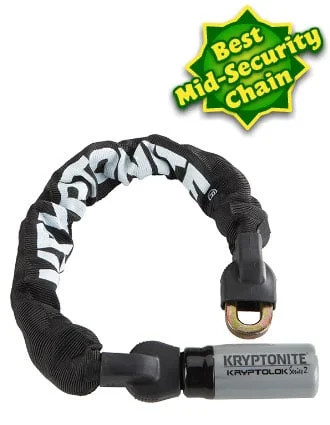 Kryptonite Krptolock Series 2 955 Mini, a best mid-security chain recommended bike lock, product shot
Kryptonite Krptolock Series 2 955 Mini, a best mid-security chain recommended bike lock, product shot
Image: Product view of the Kryptonite Kryptolok Series 2 955 Mini chain lock, highlighting its features and compact design as a recommended mid-security chain option.
| KryptoLok Series 2 955 Mini |
|—|—|
| My score: | |
| Check price: | > Check Amazon Price |
| Chain thickness: | 9 mm |
| Weight: | 3.90 lb (1.77 kg) |
| Length: | 21.5″ (55 cm) |
| Kryptonite rating: | 6/10 |
| Security Ratings: | |
For optimal security, keep the chain as far off the ground as possible to minimize vulnerability to bolt cutters. Wrapping it around your seat stays, as pictured, is a recommended technique. Alternatively, secure it around your top tube and explore additional methods to protect your wheels.
If you prioritize portability and prefer the enhanced locking flexibility of a chain lock, and your risk level isn’t excessively high, this is a reliable and affordable option. For a similar yet more secure choice, consider the Kryptonite Evolution Series 4 1055 Mini, featuring 10 mm links, a more robust body, and recognized as the Lock Picking Lawyer’s preferred lock!
Read my detailed, hands-on review of the Kryptonite Kryptolok Series 2 955 Mini. For more information on chain locks and to help you decide if this type is right for you, I have written extensively about chain locks.
6. Litelok Core Plus
One of the most significant challenges with bike locks is convenient portability. Locks are often bulky and heavy, and frame mounts can be unsightly and unreliable. These issues are amplified when using larger locks for increased security.
Enter the concept of “wearable” bike locks. The Litelok Core Plus is the most secure “wearable” bike lock currently available, boasting a Diamond rating from Sold Secure, making it a top recommended bike lock for wearable security.
 Litelok Core Plus securing a bicycle frame and back wheel, highlighting its wearable design
Litelok Core Plus securing a bicycle frame and back wheel, highlighting its wearable design
Image: Litelok Core Plus bike lock securing both the frame and rear wheel of a bicycle, demonstrating its effective application and wearable design as a highly recommended security solution.
Liteloks are constructed from a material they call “Boaflexicore,” a sophisticated cable composite, distinct from typical cable locks. The Litelok Core Plus utilizes an enhanced Boaflexicore Plus, specifically engineered to resist advanced cable cutters. In fact, it’s highly improbable that anything other than an angle grinder could cut through the Litelok Core Plus.
What I particularly appreciate about the Litelok Core Plus is its portability; when not securing your bike, it can be worn around your waist like a belt! While not the first bike lock to offer this feature—the Hiplok Gold chain can also be worn this way—I consider the Litelok Core Plus superior for several reasons.
Firstly, it’s more secure. The Hiplok Gold chain has a lower Sold Secure Gold rating and is vulnerable to bolt cutters, which pose no threat to the Litelok Core Plus. Secondly, the Litelok is lighter and more comfortable to wear around the waist.
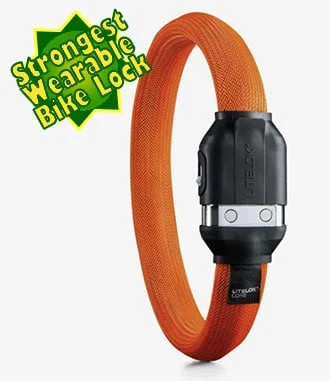 Litelok Core Plus product shot, showcasing its award-winning design as a recommended bike lock
Litelok Core Plus product shot, showcasing its award-winning design as a recommended bike lock
Image: Product showcase of the Litelok Core Plus bike lock, emphasizing its award recognition and innovative design as a top recommended wearable security solution.
| Litelok Core Plus |
|—|—|
| My score: | |
| Check price: | > Check Litelok Core Price |
| Waist Size | 22″ – 42″ |
| Weight: | 4.1 lb (1.9 kg) |
| Length: | 29″ (75 cm) |
| Security Ratings: | |
It’s not without minor drawbacks. Threading the Litelok’s end through wheel spokes can be tricky in certain situations. While available in two lengths, the wearable belt functionality limits you to the size that fits your waist.
However, I can’t think of another Diamond-rated lock as easily portable. Even the smaller Litelok Core offers a generous locking circumference, providing ample options for securing your bike. While wearing a bike lock around your waist isn’t for everyone (it can also be strapped to your frame), if it suits your lifestyle, the Litelok Core Plus is an exceptionally secure and versatile choice. Read my comprehensive, hands-on review of the Litelok Core Plus for more details.
How to Choose the Right Bike Lock for You
If none of my top 6 Recommended Bike Locks seem quite right, don’t worry! Keep reading, and I’ll guide you through 3 simple steps that guarantee you’ll find the perfect lock for both you and your bicycle.
As I’ve emphasized, the best bike locks not only protect your bike but are also convenient for daily use. Your individual circumstances are crucial, including the type of bike you own, its value, your usage patterns, and your budget.
This may seem like a lot to consider, but by following these 3 steps, the process becomes straightforward:
- Choose the right level of security
- Choose the right type of lock
- Choose the right size lock.
In Step 1, we’ll determine the necessary security level for your bike and guide you to locks offering appropriate protection. Step 2 introduces various bike lock types, helping you select the lock type that best fits your needs. Finally, Step 3 explains how to choose the right size lock for your bike type and locking preferences.
Step 1: Choose the right level of security
Step 2: Choose the right type of bike lock
Step 3: Choose the right size lock
Which company makes the best bike locks?
Making the Final Decision
Do bike thieves use lock picking techniques?
What’s the strongest bike lock?
What’s the lightest bike lock?
How can I protect my bike wheels and seat?
What’s the best way to lock my bike?
Ready? Let’s begin!
Step 1: Choose the Right Level of Security
The primary function of any bike lock is to prevent theft. Therefore, determining the necessary security level is the most critical first step. However, choosing a bike lock isn’t simply about selecting the strongest option. Increased security often means greater weight or smaller size, or often both.
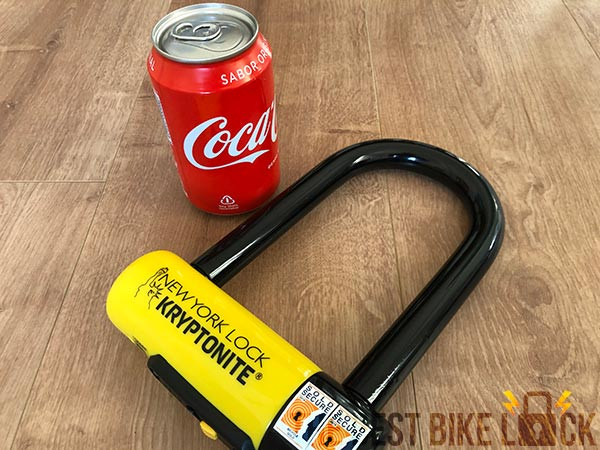 Kryptonite Fahgettaboudit Mini showcasing its compact size and robust build, a strong but less versatile recommended bike lock
Kryptonite Fahgettaboudit Mini showcasing its compact size and robust build, a strong but less versatile recommended bike lock
Choosing a lock that’s insufficiently secure leaves your bike vulnerable to theft. Conversely, a lock that exceeds your security needs can be unnecessarily heavy or cumbersome, making it less practical without providing added benefit. This impracticality might lead to improper use or even abandonment of the lock, still resulting in bike theft.
Matching your lock’s strength to your actual risk level is essential. The easiest way to assess your risk is by answering these 3 questions in this quick quiz:
If you’ve completed the quiz, you’ll receive a recommendation for a Sold Secure Silver, Gold, or Diamond rated bike lock. You may now be wondering, “What is Sold Secure?”
Who are Sold Secure?
Sold Secure is an independent organization that rigorously tests and rates security products, including bike locks, according to their protective capabilities.
Sold Secure classifies locks from Bronze to Diamond based on their resistance time against attacks. Bike locks are rated Bronze (least secure), Silver, Gold, or Diamond (most secure), reflecting their ability to withstand attacks in the Sold Secure testing lab.
- Diamond locks: “provide the highest level of security … aimed at very high value bicycles and e-bikes.”
- Gold locks: “offer the next highest level of security, aimed at mid-to-high value bicycles.”
- Silver locks: “offer a compromise between security and cost.”
- Bronze locks: “typically offer defence against the opportunist thief.”
Why Trust Sold Secure?
Sold Secure tests and rates more bike locks than any other organization. They utilize standardized tools and methods informed by real-world bike theft techniques, including both brute force and picking methods. They maintain close collaborations with police and insurance companies to ensure their testing remains current with evolving theft tactics. Locks must be resubmitted annually for testing to retain their rating.
 Inside the Sold Secure testing lab, showcasing their rigorous evaluation of recommended bike locks
Inside the Sold Secure testing lab, showcasing their rigorous evaluation of recommended bike locks
Most insurance companies require the use of a Sold Secure rated lock for bike insurance coverage, with the level of coverage often dependent on the lock’s rating. Using a non-rated lock typically invalidates insurance claims in case of theft. Therefore, Sold Secure ratings are highly trustworthy. They possess extensive expertise in security testing.
While Sold Secure is a leading authority, other methods exist to assess bike lock strength, which are also worth considering.
Other Independent Testers
Sold Secure is not the only independent body evaluating bike lock security. In the Netherlands, ART provides a similar service, rating locks from 1 to 5 stars (5 being the strongest) based on their resistance to attack.
ART employs a 1-5 star system, known for stricter standards but rating fewer locks than Sold Secure. ART’s ratings are based on both machine tests (tensile strength, torsion strength, cutting, corrosion, dust, and freeze tests) and expert engineer assessments (brute and intelligent attack tests):
- 1 star: minimum security
- 2 stars: for bicycles
- 3 stars: for mopeds and scooters
- 4 stars: for motorcycles (on the road)
- 5 stars: for motorcycles (parked at home)
Sold Secure vs ART
ART tests and rates fewer locks than Sold Secure, with a narrower classification range. However, used in conjunction with Sold Secure ratings, ART ratings can provide a more nuanced understanding of a lock’s security. For example, if two locks both have a Sold Secure Gold rating, but one has 2/5 stars from ART while the other has 3/5, the latter is demonstrably more secure. This comparison is particularly useful for differentiating security levels among similarly rated locks.
Online Tests (Often Unreliable)
Numerous cycling and product review websites publish articles detailing their bike lock attack tests using various tools to determine the “best” lock. While these can be entertaining, their reliability is questionable.
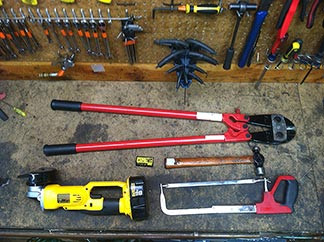 Tools used for bike lock testing, often seen in online reviews but less standardized than professional ratings
Tools used for bike lock testing, often seen in online reviews but less standardized than professional ratings
These tests typically evaluate few locks, lack standardized tools and methods, and may not replicate real-world theft techniques. Crucially, effectiveness against tools not commonly used by thieves is irrelevant. Thieves carry limited tool sets: cable cutters, medium-sized bolt cutters, pry bars, and angle grinders. They do not use nut splitters, drills (anymore), and they do not pick locks!
Furthermore, these online tests often overlook practicality factors, such as portability and ease of use, which are vital considerations as there is no “one-size-fits-all” bike lock solution. Beyond basic conclusions like “cable locks are weak” and “angle grinders cut through everything,” their findings are often uncertain and not particularly helpful. Many recommendations on high-profile websites are demonstrably incorrect, undermining their trustworthiness.
Lock Brand Ratings (Can Be Confusing)
Major lock brands have developed their own rating systems to help consumers compare security levels within their product lines.
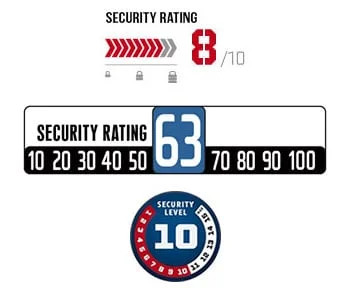 Comparison of different lock brand security ratings from Kryptonite, OnGuard, and Abus, illustrating the confusion in brand-specific ratings
Comparison of different lock brand security ratings from Kryptonite, OnGuard, and Abus, illustrating the confusion in brand-specific ratings
While useful for comparing locks within a single brand, these systems are inconsistent across brands, making cross-brand comparisons difficult.
How I Use Sold Secure Ratings
The bottom line is: determine your risk level using the quiz above. “High risk” scenarios necessitate Gold or Diamond rated locks. “Lower risk” situations may be adequately addressed with Silver rated locks.
| Risk Level | High Risk | Lower Risk |
|---|---|---|
| Recommended Security Rating |
I generally advise against Sold Secure Bronze locks due to their minimal practical protection. While they might suffice in extremely low-risk areas, I’m hesitant to recommend locks so easily defeated. Given the wide variety of locks available at different sizes, weights, and prices, you should be able to find a Sold Secure Silver or higher-rated lock that fits your specific needs.
Step 2: Choose the Right Type of Bike Lock
This step is almost as important as Step 1. The type of lock significantly affects usability. A cumbersome or difficult-to-use lock is likely to be used improperly or less frequently, increasing the risk of theft. Therefore, avoid locks that are too heavy, too small, difficult to carry, complicated to secure, or that severely restrict locking locations.
Consider your individual circumstances when choosing a lock type. Let’s examine the advantages and disadvantages of each main type to guide your decision. There are four primary types of bike locks:
- U-locks
- Chain locks
- Folding locks
- Cable locks
Each type represents a trade-off between three fundamental qualities:
- Price
- Practicality
- Security
Notice that u-locks, chain locks, and folding locks offer a reasonable balance of price, practicality, and security, whereas cable locks do not. While cable locks may be inexpensive and easy to use, their security is minimal. Therefore, avoid cable locks!
To determine the best type for your needs, let’s explore each in detail.
U-locks / D-locks
U-locks, also known as D-locks, are essentially large padlocks that secure your bike to a fixed object.
| U-locks: Pros and Cons |
|—|—|
| Pros | – More affordable than chain locks – Lighter than chain locks – More secure than folding locks |
| Cons | – Less portable – Limited reach for larger objects |
Good u-locks balance price, practicality, and security effectively. They are generally cheaper, lighter, and slightly easier to use than chain locks while still providing high security. Their rigid shape can make them less portable than chains, and their limited size restricts the types of objects they can secure your bike to.
However, for many, a u-lock is an excellent primary bike lock. Prices range from around $30 / £18 for budget-friendly models to $300 / £300 for top-tier, highly secure options, accommodating various budgets.
Consider size and portability carefully before purchasing a u-lock. The two u-locks recommended earlier are standard size, versatile enough for most locking scenarios and bike types. Smaller u-locks are also available and increasingly popular. Let’s look at one example:
Kryptonite New-U Evolution Mini-7
The Evolution Mini-7 is highly rated and recommended, but its smaller size may not suit everyone.
| Kryptonite New-U Evolution Mini-7 |
|—|—|
| My score: | |
| Check price: | > Check Amazon Price |
| Shackle thickness: | 13 mm |
| Weight: | 3.55 lb (1.61 kg) |
| Size (internal): | 3.25 x 7″ (8.3 x 17.8 cm) |
| Kryptonite rating: | 7/10 |
| Security Ratings: | |
The Mini-7 has many appealing features. Its 13 mm shackle, made from Kryptonite’s strongest “max performance” steel, locks into the crossbar on both sides, enhancing resistance to cutting and leverage attacks, reflected in its Gold Sold Secure rating. It includes a cable for securing the wheel not covered by the u-lock and a decent frame mount (if properly installed).
It’s more secure than the Kryptonite Kryptolok and lighter than the Litelok X1 and many other Gold and Diamond rated locks (weighing less than 3 cans of soda without the cable).
 Kryptonite Evolution Mini-7 securing a bicycle wheel and frame, illustrating its compact application
Kryptonite Evolution Mini-7 securing a bicycle wheel and frame, illustrating its compact application
Image: Kryptonite Evolution Mini-7 bike lock in use, securing the bicycle frame and wheel, demonstrating its application and compact size as a recommended option for certain users.
However, consider these points before purchasing: While Sold Secure Gold rated, its 2/5 ART rating places it on the lower end of the Gold security spectrum. It offers excellent security but isn’t among the absolute strongest and provides no resistance against angle grinders.
Secondly, it’s a mini u-lock. Its narrow width limits its use primarily to bike racks. Depending on your bike, it may not be able to secure your wheel, frame, and the rack simultaneously, especially with wider tires or thicker frames.
However, with flexible locking techniques, you can effectively secure most bike types to racks with this lock. While I find it effective for my needs, its rack-centric design makes it less universally recommended. Read my full review of the Kryptonite Evolution Mini-7 for more details.
Chain locks
Chain locks consist of a metal chain, usually covered with a protective sleeve, and a robust lock.
| Chain locks: Pros and Cons |
|—|—|
| Pros | – More portable than u-locks – Versatile for securing to various objects |
| Cons | – Very heavy – More expensive |
Chain locks can be broadly categorized into:
- Portable Chains: Light enough for daily carry.
- Stationary Chains: Too heavy for portability, best for fixed locations (> 12 mm link thickness).
Portable Chains
These are easily carried wrapped around seat posts or in bags, and their length and flexibility allow securing bikes to diverse objects. However, chains under 12 mm thick are generally less secure than good u-locks and are still heavier.
Stationary Chains
Very thick, hardened steel chains with high-quality padlocks offer maximum bike security. However, their extreme weight makes them best suited as stationary, secondary locks left at regular parking locations.
Chain lock prices range from around $45 / £40 for basic models to over $500 / £200 for heavy-duty, high-security chains, generally more expensive than u-locks. Consider size, thickness, and portability needs when choosing a chain lock.
The Kryptolok and Evolution chains recommended earlier are suitable for portable security. Let’s examine a top stationary chain lock:
The Strongest Static Chain Lock: Kryptonite New York Legend 1515
While Pragmasis likely makes the strongest chains, their limited availability makes the Kryptonite New York Legend Chain 1515 the most secure widely available bike chain lock.
| New York Legend 1515 |
|—|—|
| My score: | |
| Check price: | > Check Amazon Price |
| Chain thickness: | 15 mm |
| Weight: | 15.95 lb (7.23 kg) |
| Length: | 60″ (150 cm) |
| Kryptonite rating: | 10/10 |
| Security Ratings: | |
With 15 mm links, it’s definitively not portable. This lock is designed to remain at a fixed location where your bike is regularly parked long-term. It boasts a 5/5 ART rating, a rare achievement. Available in 5′ and 3′ lengths, it can secure single or multiple bikes. If you need ultimate security for your bike shed or other bike storage solution, this is an exceptional, though expensive, choice. Read my full review of the New York Legend Chain 1515 and my comparison of other chain locks.
Folding Locks
Folding locks consist of interconnected metal plates joined by rivets. They fold compactly for transport and unfold to secure your bike.
| Folding locks: Pros and Cons |
|—|—|
| Pros | – Most portable lock type – Versatile reach for various objects – Relatively lightweight |
| Cons | – Limited secure options – Durability concerns |
They are generally slightly heavier than similarly secure u-locks but offer greater flexibility in locking options due to their length and articulation. Their primary advantage is their compact folded form, making them exceptionally portable. Carrying holsters typically attach via Velcro or bottle holder mounts on your bike frame.
Image: An Abus Bordo folding lock neatly folded and mounted on a bicycle frame, highlighting its compact and convenient portability, a key feature of recommended folding bike locks.
Their compactness prevents looseness or interference during rides, a common issue with some u-lock mounts. While perhaps slightly less convenient to lock than u-locks or chains due to unfolding and maneuvering, their portability is a significant benefit. Durability after attempted theft might be a concern due to their complex construction. However, for users prioritizing portability over ultimate brute force security, folding locks are excellent.
Cable locks (Avoid!)
Cable locks are made of braided steel strands encased in plastic.
| Cable locks: Pros and Cons |
|—|—|
| Pros | – Long reach – Lightweight – Inexpensive – Practical to carry |
| Cons | – Bike will likely be stolen |
They are lightweight, flexible, and inexpensive. However, this flexibility also makes them easily cuttable with handheld cable or bolt cutters within seconds. Since cable cutters are common tools among bike thieves, cable locks offer minimal practical security. Bike thieves often target cable locks specifically. Statistics suggest that a high percentage of stolen bikes were secured with cable locks.
Avoid cable locks entirely. While they can be used as secondary locks for wheels or saddles, better, more secure methods exist for component protection, which we will discuss later.
Innovative Locks
A category of bike locks emerges from independent innovators, often funded through crowdfunding platforms.
| Innovative locks: Pros and Cons |
|—|—|
| Pros | – Address limitations of traditional locks – Utilize new technologies |
| Cons | – Often expensive – Largely untested security |
Many innovative locks lack independent security testing (Sold Secure or ART), a critical oversight for security products. However, some have achieved ratings and are worth considering, such as the titanium TiGr Mini and the textile Tex-lock. These innovative locks tend to be pricier for their security level and are best considered only if they address specific usability issues not met by traditional locks.
U-locks vs Chain locks vs Folding locks
I discuss u-locks and chain locks in detail in my u-lock vs chain lock comparison. Here’s a summary:
Portable Security
For everyday carry, u-locks are generally the best choice for portable security. Lighter, cheaper, and more secure than portable chains, they offer the best balance of security, practicality, and price.
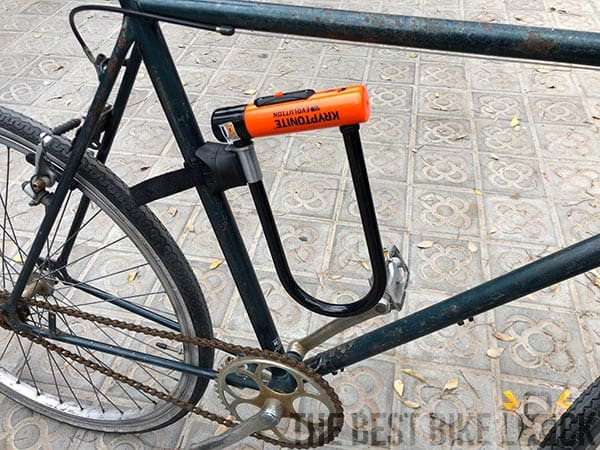 Kryptonite Evolution Standard u-lock mounted on a bike frame, recommended for portable security
Kryptonite Evolution Standard u-lock mounted on a bike frame, recommended for portable security
Chains might be preferred for greater locking flexibility or if u-lock frame mounts are undesirable. However, u-locks are typically the best portable security option.
Stationary Security
For fixed locations like home or work, heavy chains offer superior stationary security. Thick chains with strong padlocks provide the highest security level.
Image: A high-security chain lock paired with a ground anchor, demonstrating a robust setup for stationary bike security, recommended for maximum protection at fixed locations like home or work.
They resist power tools better, are bolt-cutter proof (16 mm+), and immune to bottle jack attacks. They can secure multiple bikes and work well with ground anchors. However, their weight makes them unsuitable for daily carry.
Folding Locks
Folding locks are also best for mobile security, addressing u-lock rigidity and portability issues. Their flexibility increases locking options, and their compact folded size enhances portability. They are weight-competitive with u-locks, though usually slightly heavier.
Image: An Abus Bordo Granit X Plus 6500 folding lock mounted on a bicycle, showcasing its high security and portability, making it a recommended option for users needing both.
However, high-security folding locks are generally less secure and more expensive than high-security u-locks. Choice is limited to brands like Abus, Seatylock, Trelock, and Kryptonite. Consider folding locks if u-locks don’t meet your specific needs, before opting for chains.
Step 3: Choose the Right Size Lock
Once you’ve determined the necessary security level and lock type, consider the size. Lock size significantly impacts usability. Ideally, use the smallest, lightest bike lock possible. This might work for slim road bikes in cities with plentiful bike racks. However, bulkier bikes like e-bikes, mountain bikes, or cruisers, or areas lacking bike racks, require larger locks.
How you lock your bike also matters. Standard advice is to secure both frame and rear wheel, requiring a lock large enough to encompass both. However, alternative wheel security methods exist, allowing you to use a smaller lock just for the frame. Consider your locking technique before choosing a size.
Generally, larger bikes (e-bikes, mountain bikes, cruisers, city bikes, comfort bikes, tandems, BMXs) need locks with a locking circumference at least as large as a standard u-lock (~85 cm). Slimmer bikes (road bikes, hybrid bikes, fixies/single speeds) may suffice with mini u-locks or smaller folding locks. Assess your specific needs carefully.
Which Company Makes the Best Bike Locks?
After deciding on security level, type, and size, you’ll encounter many similar locks from various brands. How to choose? Let’s compare three popular brands:
Abus vs Kryptonite vs OnGuard
I compare these brands in detail in my Abus vs Kryptonite vs OnGuard comparison, including a detailed review of their “Anti-theft Protection” schemes. Here’s a summary:
Abus produces the highest quality locks: well-made, rigorously tested, reliable, and durable, even in harsh conditions. However, they are the most expensive.
Kryptonite also offers high-quality locks, slightly below Abus in build quality, but compensates with exceptional customer service, including free key and lock replacement in certain situations and the best anti-theft protection schemes.
OnGuard has historically had a poorer reputation for build quality and customer service. However, quality has improved significantly recently, and they are consistently the most affordable option.
Choose Abus for top quality, OnGuard for best price, and Kryptonite for superior customer service.
Other Good Bike Lock Brands
Beyond the “big three,” other brands deserve consideration. In 2024, my top 6 recommendations include more niche brands than established ones, with two locks each from Litelok and Seatylock (Foldylocks).
 Hiplok bike lock attached to a belt, showcasing wearable security and alternative brands
Hiplok bike lock attached to a belt, showcasing wearable security and alternative brands
Hiplok specializes in wearable bike locks, such as waist-worn chains and belt-clipped u-locks, prioritizing convenient lock transport. Smaller brands often drive innovation, which larger brands may eventually adopt.
Making the Final Decision
Following these three steps should guide you to the ideal security level, lock type, size, and brand. If my top 6 recommendations aren’t suitable, browse comprehensive lists of Sold Secure Silver, Gold, or Diamond locks based on your risk level, comparing sizes, weights, and prices to find your perfect match!
How Much Money Should I Spend?
Generally, higher spending equates to better lock quality, primarily in reliability. Reliability is crucial for bike locks. Avoid locks with keys that malfunction, mechanisms that jam, or shackles that stick. Malfunctioning locks can cause significant problems.
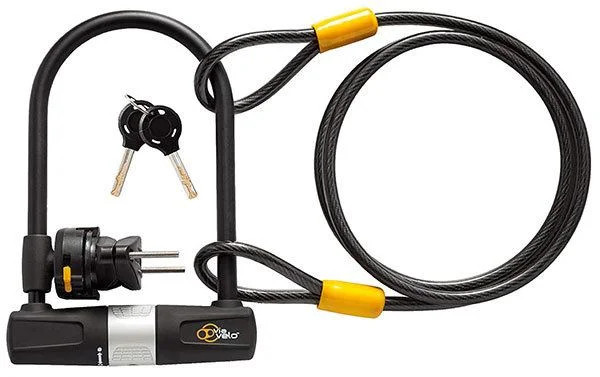 Cheap u-lock, often insecure and unreliable, highlighting the risks of budget options
Cheap u-lock, often insecure and unreliable, highlighting the risks of budget options
A lock that fails while securing your bike renders it unusable until the lock is removed, which can be difficult and costly. A lock that fails before securing your bike risks theft. Higher-quality locks minimize these risks.
While some cheap, high-security locks exist, and many expensive low-security ones too, generally, high-security locks cost more. Reliable, high-security locks always cost more!
 Infographic suggesting spending on bike lock security, advising investment for long-term savings and peace of mind
Infographic suggesting spending on bike lock security, advising investment for long-term savings and peace of mind
Many brands suggest spending 10% of your bike’s value on a lock. However, for a $200 bike, a $20 lock is likely insufficient. Spend as much as you can afford for optimal reliability and security. A good lock can last for years and across multiple bikes. Upgrading your bike later won’t necessitate a new lock purchase.
While buying a bike lock isn’t exciting, and spending money on security is frustrating, a cheap lock is false economy. A jammed lock will require professional removal and replacement costs. Bike theft necessitates replacing both the bike and the lock. Invest wisely initially to avoid greater costs later.
Frequently Asked Questions
This section addresses common questions about bike locks to provide further clarity for your choice.
Do Bike Thieves Use Lock Picking Techniques?
No, most bike thieves lack lock-picking skills. Basic bike locks are easily defeated with brute force, negating the need for picking. While a small percentage might have basic lock-raking tools, their limited skills are negligible against decent locks. Expert lock pickers like Bosnian Bill and the Lock Picking Lawyer are highly skilled professionals using specialized tools in controlled settings. Their ability to quickly open locks doesn’t translate to typical street theft scenarios.
While the Lock Picking Lawyer can open even good locks quickly in videos, as he mentions, such locks have “enough pick resistance to use in the street” because street thieves lack his tools and expertise.
However, understanding lock mechanisms is useful. Four common types are: disc detainer, slider, pin tumbler, and wafer. Disc detainer mechanisms, pioneered by Abloy and used in high-quality locks like Abus and Kryptonite, are durable and pick-resistant. Slider mechanisms, common in budget locks like OnGuard and Zefal, vary in pick resistance depending on implementation. Pin tumbler and wafer mechanisms are generally less secure, being more vulnerable to raking attacks, with wafer mechanisms being particularly easy to open and best avoided.
What’s the Strongest Bike Lock?
The strongest bike locks are the Litelok X3 and Hiplok D1000. In my tests, the Litelok X3 slightly outperformed the Hiplok D1000. Both offer exceptional angle grinder resistance, approaching “angle grinder proof” in real-world scenarios. However, both are heavy and expensive. The Litelok X1 is a more practical option for many, offering significant angle grinder resistance, far exceeding other locks, while being lighter, better sized, and cheaper, with a frame mount included.
 Kryptonite Fahgettaboudit Mini securing a bike frame and wheel, known for strength but less versatile than other recommended bike locks
Kryptonite Fahgettaboudit Mini securing a bike frame and wheel, known for strength but less versatile than other recommended bike locks
See my Litelok X1 review for details and angle grinder test videos. I have also written an article about the strongest bike locks. Remember, increased lock strength often comes with increased weight and/or reduced size.
What’s the Lightest Bike Lock?
The lightest recommended bike lock is the TiGr Mini. However, lightweight locks often compromise security or size, or are very expensive. “Lightweight” is subjective for bike locks.
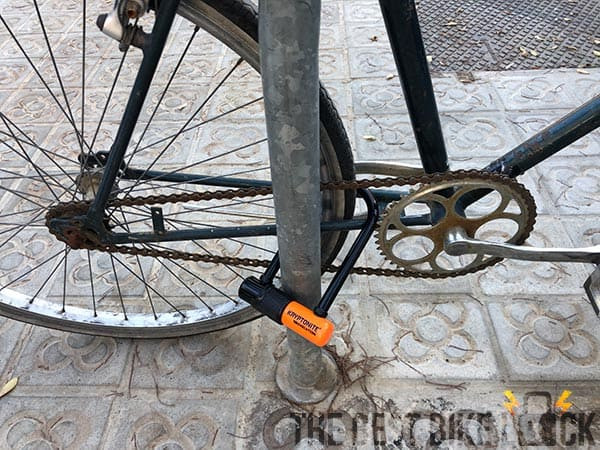 Kryptonite Evolution LITE Mini-6, a lightweight recommended bike lock option, product view
Kryptonite Evolution LITE Mini-6, a lightweight recommended bike lock option, product view
Carefully compare weight, size, and price to ensure trade-offs are acceptable for your needs. See my article on the lightest bike locks for more information.
How Can I Protect My Bike Wheels and Seat?
Bike wheels and seats can be protected using extra locks, cable lassos, security skewers, hex bolt blockers, and DIY methods.
 Hexlox wheel skewer, a component security solution for protecting bike wheels and parts
Hexlox wheel skewer, a component security solution for protecting bike wheels and parts
My article on securing bike wheels and seats details available options.
What’s the Best Way to Lock My Bike?
There’s no single “best” way to lock a bike, but many incorrect methods guarantee theft. My comprehensive article on how to lock a bike covers effective and ineffective locking techniques. Read this before deciding on a lock.
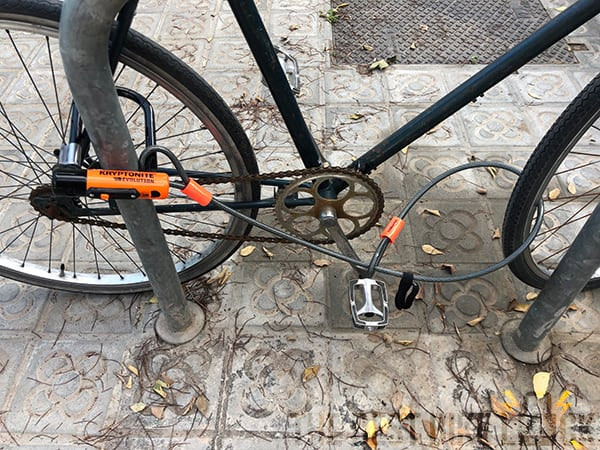 Kryptonite Evolution Mini-7 u-lock with cable, illustrating secure bike locking techniques and recommended methods
Kryptonite Evolution Mini-7 u-lock with cable, illustrating secure bike locking techniques and recommended methods
Understanding secure locking methods, including potentially lesser-known techniques, can help you choose a more user-friendly, possibly smaller and lighter, lock.
This page contains affiliate links, which means I may earn a small commission if you click through and make a purchase. You will not pay any extra. More details here.
More Good Stuff:
Sold Secure Gold Bike Locks: The List
Win a Free Bike!
How to lock you bike (properly)

